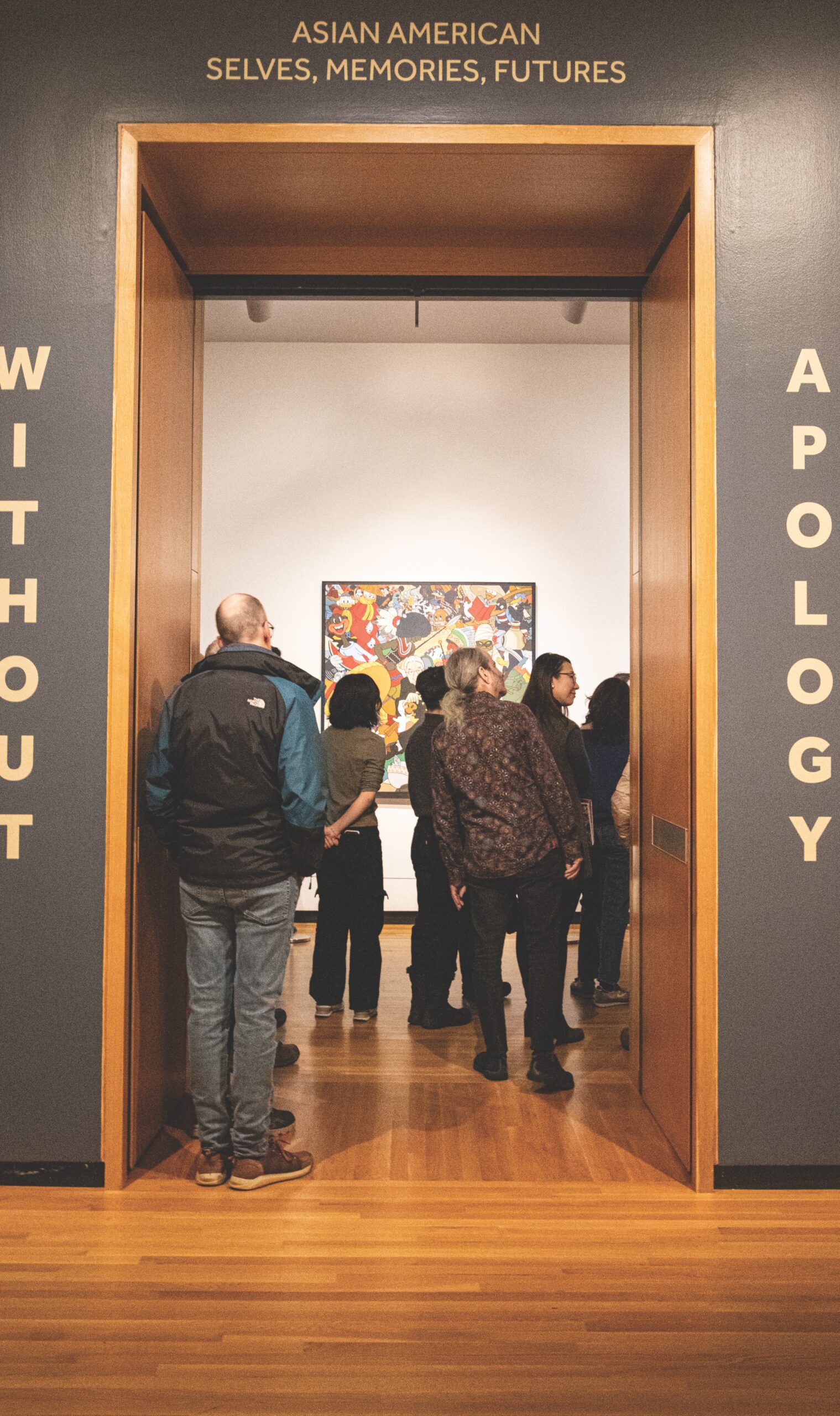BCMA’s “Without Apology” explores Asian American identity, racialized narratives and self-expression
January 26, 2024
 Isa Cruz
Isa CruzThe Bowdoin College Museum of Art (BCMA) held a gallery tour and reception for its newest exhibition, “Without Apology: Asian American Selves, Memories, Futures” yesterday. The exhibition, which opened in December, is the first at the museum to center Asian American artists at Bowdoin and aims to showcase the breadth of Asian American art, reframe racialized narratives and explore Asian American identity.
The exhibition is part of the College’s yearlong Asian American Reckonings initiative and was co-curated by Professor of History and Environmental Studies Connie Chiang, Assistant Professor of Sociology Shruti Devgan, Professor of Asian Studies and English Belinda Kong, Professor of Social Sciences Nancy Riley and Professor of Asian Studies and Cinema Studies Shu-chin Tsui. BCMA Curator Casey Braun, Post-Baccalaureate Curatorial Assistant Sabrina Lin ’21 and Emily Pratt ’24 provided curatorial support.
Featuring works spanning from the 1940s to 2023, the exhibition encapsulates themes of imperialism, racism and displacement while also highlighting vibrant and colorful works to showcase cultural joy and beauty.
The idea for an installation at the BCMA featuring Asian American art began several years ago among the faculty group, and after securing funding, they began officially planning this installation in December 2022.
“I really think Bowdoin needs this. I’m really proud of it and that we were able to help contribute to Bowdoin thinking more broadly about race and ethnicity,” Riley said.
The curators, who emphasized that they come from academic rather than artistic backgrounds, worked together to determine which artists they felt compelled to feature in the exhibition, discovering new pieces during the research process. “Without Apology” combines works from the BCMA’s permanent collection, pieces the museum acquired for this project and loans from other institutions.
“During the initial search, we were casting a very broad net. We were finding new things that we had previously not really paid attention to, and we were using the permanent collection as a point of departure to think about what stories we could tell,” Lin said.
The exhibition is organized into three sections, but the curators stressed that the pieces and their themes are fluid. The first area, entitled “Memories,” explores past narratives and traumatic historical events. The earliest works in the exhibition are by Chiura Obata, a Japanese-American artist who was incarcerated at the Utah internment camp, Topaz Relocation Center, in 1942 following the bombing of Pearl Harbor and the national imprisonment of Japanese Americans across the United States. Obata continued to make art and even started an art school while incarcerated at Topaz.
“[Obata] made over 100 line-drawings, quick brush stroke depictions of camp life,” Chiang said at the gallery talk. “Obata was a landscape artist, and he found a lot of strength, beauty and metaphor in the natural world…. He’s documenting what happened, but not in a way without commentary. He is showing hardship and challenges and the injustice Japanese Americans experienced.”
Brunswick resident Patty Richter found the gallery tour informative and was surprised to learn about Obata’s work from Topaz.
“The thing that stunned me the most was the internment camp art. We had no idea how extreme the degradation in the camps must have been, but [Obata] memorialized it,” Richter said. “I thought that there was so much in-depth curation from the faculty and the students were terrific. I think it’s long overdue that we examine this art.”
Kong highlighted Stephanie H. Shih’s ceramic sculptures, which resemble food items commonly found in Chinese American households. BCMA curators Lin and Braun went to Shih’s shop and bought the ceramics specifically for the exhibition.
The “Regenerations” section explores how Asian American artists have sought to reconstruct the past and define the present. At the talk, Riley spoke about a sculpture of a child by Tuan Nguyen that was created with laundered paper. Riley shared how the reuse of the paper was symbolic of a refugee’s challenging journey to a new life.
Riley also highlighted a drawing of the Maine coast by Reuben Tam, an artist who lived in the continental United States and Hawaii.
“[Tam was] an Asian American artist, but one thing this reminds us of, is that Asian American artists aren’t necessarily focused on a particular theme. They are also doing different kinds of work,” Riley said.
The third section, “Selves,” highlights self-portraits and expressions of identity. Tsui discussed a digital drawing by Jason Raish that shows a young Asian American boy eating by himself in a school cafeteria. Tsui said the piece depicts how tendencies of racial segregation can develop among children.
A focal point of the second gallery is Roger Shimomura’s “American vs. Disney Stereotypes.” The colorful painting depicts Shimomura as an American figure among a variety of racial stereotypes.
“The Roger Shimomura piece shows him standing up to stereotypes, but it also suggests that it’s not just about Asian Americans,” Chiang said in an interview with the Orient. “There’s this larger connection to other marginalized groups or racial minorities who have also been subjected to these stereotypes. We wanted to show Asian Americans as not objects of art, but as makers of art.”
The faculty curators hope that visitors leave with a broadened view of Asian American art and an appreciation for its vibrancy and boldness.
“We made this exhibit without apology. This idea that Asian Americans, whether they’re artists or not, [we wanted to show] identity, assertion of culture, of community, of family without apology,” Chiang said. “That unapologetic expression of these various artists was really important to us.”

Comments
Before submitting a comment, please review our comment policy. Some key points from the policy: